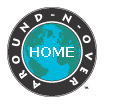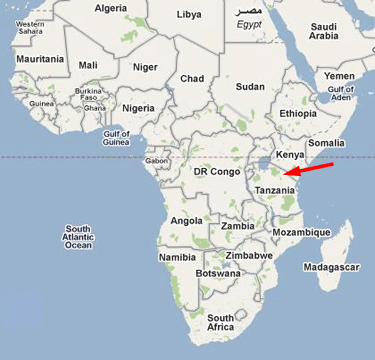 |
| About us |
| Education Portal |
| The Team |
| Our Projects |
| Our Score Card |
| Partners |
| Sponsors |
| Media Coverage |
| Media Kit |
| Shopping Helps |
| Support us |
| Contacts |
 |
|
Onward across the Indian Ocean!
Climbing Kilimanjaro -- Stage 3 of the Six Summits Project
Definition: What is Circumnavigation?
The goal of this phase
The human powered circumnavigation made landfall on mainland Africa on 20 April 2011. There, Mt. Kilimanjaro (5,895 meters - 19,341 feet), the highest point in African continent
which is located in northern Tanzania, was summitted on 14 June 2011.
Geology
Kilimanjaro has three separate volcanic cones one of which, namely Kibo, is still active emitting gas in its crater. Uhuru Peak
is the highest point on Kibo's rim reaching 5,895 meters of altitude. Mawenzi and Shira are the other two cones which are extinct.
Recent surveys according to Wikipedia, have concluded that molten magma is about 400 meters below the crater of Kibo. The most
recent volcanic activity on this mountain was 200 ago.
Part of the Rift Valley fault line reaching all the way to the Dead Sea, Kilimanjaro began forming a million years ago. Wikipedia reports
that the last major eruption has been dated to 360,000 years ago.
Name
There are various theories on the origins of the name Kilimanjaro. Please see the Wikipedia article for details. Kilimanjaro became a part of German East Africa in the 1880's.
The first reported climb of the peak was in October 1889 by Hans Meyer who named the peak "Kaiser-Wilhelm-Spitze" (Kaiser Wilhelm
peak). These German colonies were later claimed by the British in 1918 after WW1. When Tanganyika gained its independence from Britain in
1961, the peak was named Uhuru which means freedom in Swahili.
Route details
If you do not have Google Earth, download it here.
On the globe, you will find a RED track with dispatch locations marked by date. This
indicates the path that the human powered circumnavigation effort followed. On the opposite side of the globe is the
antipodal circumnavigation track indicated in GREEN. Grey colored tracks indicate
time in transit by ship between PNG and the Philippines. If any of the tracks appear broken, then try toggling to "OpenGL"
in Google Earth's graphics preferences under Tools\Options.
Progress
For Erden, the ascent of Mt. Kosciuszko on 10 April 2010 in the southeast corner of Australia with Nancy Board was the culmination of an
almost three year effort invested toward this goal. Having concluded Stage 2, he could
now turn ever westward toward the next summit on the roster: Mt. Kilimanjaro in Africa.
Erden kept a fair pace across southern Australia, first visiting friends who were expecting him in Melbourne. From there, he bicyled
through wine country toward Murray Bridge. It was already May when he reached Port Augusta. He traveled the arid Nullarbor Plain in
the autumn of the southern hemisphere during all of the month May, reaching Perth on the first of June. All along, Erden had been depressed believing
that, due to the additional travel time which was forced on the journey through Papua New Guinea, he had missed his April launch window
out of Fremantle. The launch could have to be delayed until the following April in 2011...
When in Perth, additional studies of the climatological data revealed that departure on the Indian Ocean could still be possible in July
if Erden moved his launch point further north to Carnarvon. He could then aim for a November arrival to Mombasa with favorable seas.
The journey could push on without another major delay.
It took all of June for Erden to prepare his boat for the Indian Ocean launch. New solar panels, AIS and a wind generator were among
new parts acquired and installed on the boat. LeisureCat
in Fremantle opened their facilities to Erden, receiving his rowboat and helping with all labor. Steve and Simone Blom, friends in
Coogee hosted Erden during the last couple weeks of June before he began his ride. Steve had introduced us to the manager of LeisureCat,
Kevin Horsley who later towed Erden's rowboat to Carnarvon while Erden pedaled north the additional 900 km over a week's time. Kevin
then turned Erden over to his friend Darren Baird of Carnarvon Tackle & Marine. Darren would secure the rowboat in his compound until
departure.
The launch on the Indian Ocean from Carnarvon was on 13 July 2010. Erden soon began to communicate from his boat with the maritime
authorities about the piracy concerns on the approach to Kenyan shores. There had been the impression of higher security after an
international naval force was assembled under the name Combined Task Force. The Turkish Navy was also participating in this operation
with a modern frigate. The Maritime Liaison Office, MARLO for short, which monitors the merchant vessels around the Horn of Africa
refused to provide information to Erden on the grounds that Around-n-Over was not an established maritime business. Instead the
Turkish Naval Command at the highest levels was sincerely interested in his challenge; soon their Operations Center began to receive
the position tracking data from the ARGOS beacon on Erden's boat. The Turkish Rear Admiral Sinan Ertuğrul took over the rotation
in command for CTF in August through November. Erden received valuable advice on known piracy risks, counter measures and surveillance
flights. Based on these email exchanges with R/A Ertuğrul, Erden weighed the options then received the nod before aiming for
Mozambique. Passing close to Cap d'Ambre, Erden was to travel west then southwest toward the Comores.
To reduce the piracy risk, the Turkish Navy favored Erden to pass between the Comores islands while his intentions had instead been to
pass north of Grande Comore before turning south with the Mozambique Current. After navigating between the two islands of Moheli
and Grande Comore, Erden encountered strong counter clockwise mesoeddies which pulled him away from Mozambique shores due east. Over the
following two weeks, Erden struggled to regain control, then finally on day 137, he was able to bring his rowboat to the pier at
Mahajanga in Madagascar on 26 November 2010, just ahead of the pending cyclone season. With this effort, Erden was declared the
"first person to have rowed three oceans" by the London based Ocean Rowing Society.
After the cyclone season, Erden relaunched from Mahajanga on 26 March 2011. Mahajanga office of SDV Madagascar had been a godsend in
safekeeping his boat during the waiting period; they had helped move the boat then secured her in their warehouse. Erden was able to
follow the coastline of Madagascar toward Cap St Andre near which he crossed the antipodal track to his circumnavigation route as well.
The data on currents in the Mozambique Channel were unrelieable, they did not agree with what Erden experienced at sea. He had to
observe the alternating daily sea/land breeze patterns and deduce the currents from the boat's behavior. The variable winds farther
west made a choice of port difficult then he settled on Angoche after encountering strong southwesterly current paralleling the
Mozambique shores. After 26 challenging days, Erden officially made landfall at Angoche on 20 April at midnight localtime. This
additional 26-day effort concluded the "first ever mainland to mainland row across the Indian Ocean."
SDV AMI based in Nacala coordinated the logistical challenge of moving the rowboat to their warehouse in Nacala and securing her. While
his expedition bicycle, trailer and panniers took forever to clear Customs in Maputo, Erden pedalled north from Angoche on a borrowed
bicycle following a sand track for 144km to a point near the town of Monapo. From there, he had to continue on toward Arusha to meet
his team for a climb of Kilimanjaro and for a visit to the Mateves Secondary School, which is the charitable cause for Around-n-Over
until the time that Erden launches from Namibia on the south Atlantic.
Erden reached Arusha on June 5th, with barely enough time to join the ten other team members for a prescheduled visit to the Mateves
Secondary School. With flights and climbing arrangements already committed for the team including his 78 year old father, Erden chose
to proceed to the climb with them. The climb was completed between June 8-16; summit day was June 14, 2011. He later patched the remaining
cycling section on June 22-23 from Arusha to his walk-in point toward the first camp.
Background
In Stage 1 of the Six Summits Project
in 2003, Erden reached the summit of Denali (Mt. McKinley) by human power from his home in Seattle. He did this in the style of
Göran Kropp as a tribute to his fallen friend.
Later, between October 3rd and Christmas of 2004, Erden covered 3,980 miles across the Continental USA over 82 days. He achieved
this again in Göran style from Seattle to Miami, towing his personal climbing gear. The original plan had been to move the
ocean rowing boat around the world on a continuous path starting and ending in Miami. When further research discouraged the
Miami departure, and the Panama Canal proved a barrier, Erden's human
powered circumnavigation plans took a turn to leave from near San Francisco. Land phases would be introduced, and the boat
would have to be shipped from one side of a continent to the other.
Before continuing on with the Six Summits Expedition, Erden took a sabbatical,
and rowed solo on the Atlantic Ocean. The row had started in Lisbon as a pair, arriving at Las Palmas in the Canaries on
December 11, 2005. Erden later continued alone from Las Palmas until he crossed into the Caribbean Sea by the island of Guadeloupe,
becoming the 33rd person to row the Atlantic Ocean east to west singlehanded.
Stage 2 began from Erden's home in Seattle with the goal of reaching highest point
in Australia, Mt. Kosciuszko by human power. He bicycled from there first to Tiburon, then to Bodega Bay then launched on the Pacific
Ocean in the same ocean rowing boat on July 10, 2007. His goal was to row to Australia but
due to the stronger equatorial winds due to La Niña conditions which had developed on the Pacific Ocean after his departure, he
was not able to cross south of the Equator. Erden reached the waters of Papua New Guinea and on day 312, with an already active
typhoon season and no resupply, his rowboat had to be lifted off the water by Philippine fishermen. The same fishermen later dropped
him at the same spot after the typhoon season, and he rowed south across the Bismarck Sea to land his boat at Finsch Harbor.
Erden continued his Six Summits Expedition from Finsch Harbor to Bukawa village by beach walking over five days. From Bukawa village
to Oro Bay, it was necessary to use a sea kayak along the Solomon Sea shores of Papua New Guinea. The difficult Kokoda Track which has
historic significance especially for the Australians where they had pushed back the Japanese assault for Port Moresby during WW2,
became the path of choice to walk from Oro Bay to Port Moresby. Erden reached Cape York by rowing from there to the mouth of the
Escape River, then used a sea kayak to land at Cooktown further south. Paved roads began at Cooktown, allowing Erden to transition to
his expedition bicycle all the way to Thredbo on the foothills of Kosciuszko. For Erden and his wife Nancy, climbing to the summit of
Kosciuszko was a morning hike completed on April 10, 2010. | ||||||||||||||||||||||||||||||||||||||||||||||||||||||||||||||||
|
All Rights Reserved. |
 Completed: April 10, 2010 - June 22, 2011
Completed: April 10, 2010 - June 22, 2011